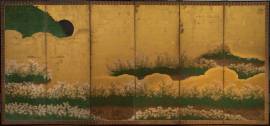Edo Period (1615-1867), 19th centurySealed by the artist in red ink, 138 by 304 cmThis pair of screens belongs to a genre of lyrical paintings of flowers, grasses, and other plants that flourished around the middle of the seventeenth century and became a specialty of the Sôtatsu studio. The use of a rather complex composition of clusters of flowers and the puddling of ink was initiated by Tawaraya Sôtatsu, the founder of the Rimpa school, who was active from 1600 until 1642. The screens are abstract and decorative but there is, at the same time, a keen sense of naturalism not only in the...
WORKS FOR SALE
Momoyama period, 17th centuryInk, colors, gold leaf, and silver on paper166 by 360 cm A field of wild pinks (nadeshiko; Dianthus superbus) blooms under a rising moon in this six-panel folding screen. The anonymous artist arranged the flowers, a relative of the carnation, in dense, rhythmical clusters in three horizontal registers in the lower half of the screen, above which clouds of gold leaf merge with the gilded sky. Interspersed between the layers of flowers are passages where flecks of silver foil, now tarnished with age, represent the ground bathed in the soft moonlight. Tiny pine...
A pair of six-panel folding screens; ink, color, gofun and gold leaf on paperKyoto Kano (Kyō-Kano) SchoolAttributed to Kano Sansetsu (1590-1651)Signature: SansetsuSeal: Jasokuken170 by 375 cm A gnarled cherry tree in full bloom and a snow-covered willow tree frame the composition of this pair of folding screens depicting flowers and trees in the four seasons. Red and white azaleas and low-growing bamboo grass (kumazasa) beneath the cherry tree complement the seasonal imagery of its pearly blossoms, while pink and white sasanquas and some sprays of marlberry (yabukōji) add touches of...
Copyright © 2016 - giuseppe piva - VAT: 05104180962










